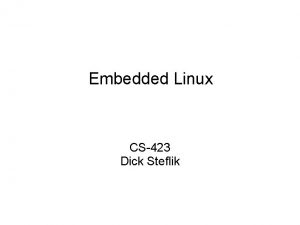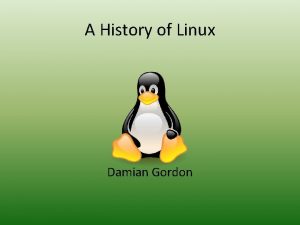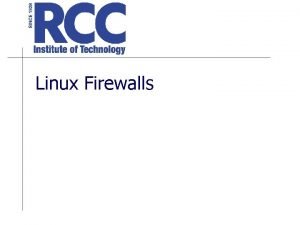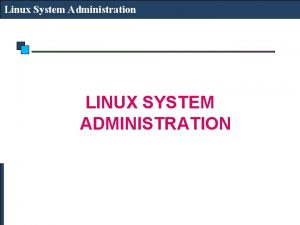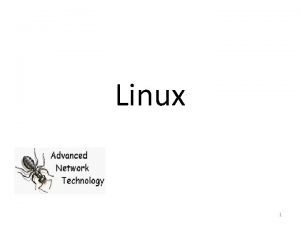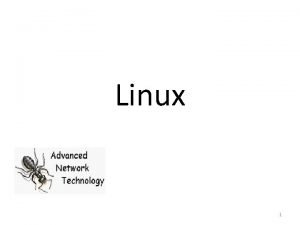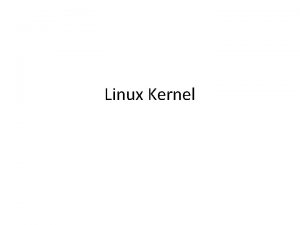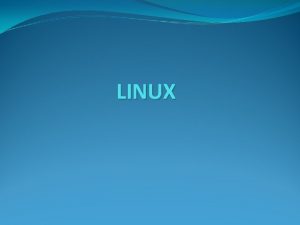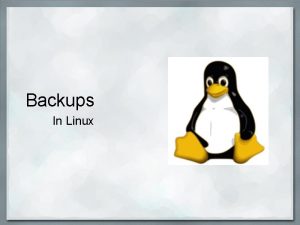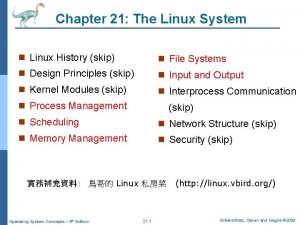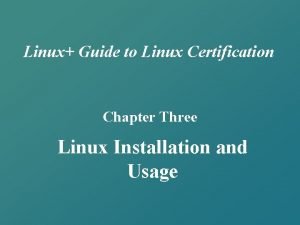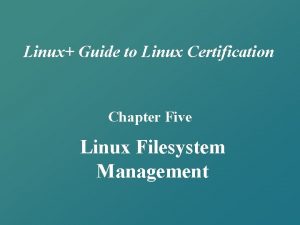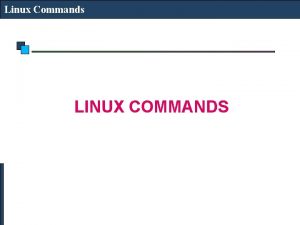Chapter 21 The Linux System n Linux History















- Slides: 15

Chapter 21: The Linux System n Linux History n File Systems n Design Principles n Input and Output n Kernel Modules n Interprocess Communication n Process Management n Network Structure n Scheduling n Security n Memory Management 實務補充資料: 鳥哥的 Linux 私房菜 Operating System Concepts – 8 th Edition 21. 1 (http: //linux. vbird. org/) Silberschatz, Galvin and Gagne © 2009

Objectives n To explore the history of the UNIX operating system from which Linux is derived and the principles which Linux is designed upon n To examine the Linux process model and illustrate how Linux schedules processes and provides interprocess communication n To look at memory management in Linux n To explore how Linux implements file systems and manages I/O devices Operating System Concepts – 8 th Edition 21. 2 Silberschatz, Galvin and Gagne © 2009

21. 1 History (不考) n Linux is a modern, free operating system based on UNIX standards First developed as a small but self-contained kernel in 1991 by Linus Torvalds, with the major design goal of UNIX compatibility l Its history has been one of collaboration by many users from all around the world, corresponding almost exclusively over the Internet l n It has been designed to run efficiently and reliably on common PC hardware, but also runs on a variety of other platforms l The core Linux operating system kernel is entirely original, but it can run much existing free UNIX software, resulting in an entire UNIX-compatible operating system free from proprietary code l Many, varying Linux Distributions including the kernel, applications, and management tools Operating System Concepts – 8 th Edition 21. 3 Silberschatz, Galvin and Gagne © 2009

Linux 2. 0 n Released in June 1996, 2. 0 added two major new capabilities: l Support for multiple architectures, including a fully 64 -bit native Alpha port 4 Available for Motorola 68000 -series processors, Sun Sparc systems, and for PC and Power. Mac systems Support for multiprocessor architectures l Other new features included: l 4 Improved memory-management code, with a unified cache for filesystem data 4 Improved TCP/IP performance 4 Support for internal kernel threads, for handling dependencies between loadable modules, and for automatic loading of modules on demand 4 Standardized configuration interface n 2. 4 and 2. 6 increased SMP support, added journaling file system, preemptive kernel, 64 -bit memory support Operating System Concepts – 8 th Edition 21. 4 Silberschatz, Galvin and Gagne © 2009

The Linux System n Linux uses many tools developed as part of Berkeley’s BSD operating system, MIT’s X Window System, and the Free Software Foundation's GNU project n The main system libraries were started by the GNU project, with improvements provided by the Linux community n Linux networking-administration tools were derived from 4. 3 BSD code; recent BSD derivatives such as Free BSD have borrowed code from Linux in return n The Linux system is maintained by a loose network of developers collaborating over the Internet, with a small number of public ftp sites acting as de facto standard repositories. The File System Hierarchy Standard specifies the overall layout of a standard Linux file system Operating System Concepts – 8 th Edition 21. 5 Silberschatz, Galvin and Gagne © 2009

Linux Distributions n Standard, precompiled sets of packages, or distributions, include the basic Linux system, system installation and management utilities, and ready-to-install packages of common UNIX tools n The first distributions managed these packages by simply providing a means of unpacking all the files into the appropriate places; modern distributions include advanced package management n Early distributions included SLS and Slackware l Red Hat and Debian are popular distributions from commercial and noncommercial sources, respectively n The RPM Package file format permits compatibility among the various Linux distributions Operating System Concepts – 8 th Edition 21. 6 Silberschatz, Galvin and Gagne © 2009

Linux Licensing n The Linux kernel is distributed under the GNU General Public License (GPL), the terms of which are set out by the Free Software Foundation l If you release software that includes any component covered by the GPL, then you must make source code available alongside any binary distributions n Linux is free, but not public-domain software l Copyrights are still held by various authors n Anyone using Linux, or creating their own derivative of Linux, may not make the derived product proprietary; software released under the GPL may not be redistributed as a binary-only product Operating System Concepts – 8 th Edition 21. 7 Silberschatz, Galvin and Gagne © 2009

21. 2 Design Principles n Linux is a multiuser, multitasking system with a full set of UNIX-compatible tools n Its file system adheres to traditional UNIX semantics, and it fully implements the standard UNIX networking model n Main design goals are speed, efficiency, and standardization l To avoid the lessons learned in UNIX n Linux is designed to be compliant with the relevant POSIX (Portable Operating System Interface for Unix) standards and threading extensions; at least two Linux distributions have achieved official POSIX certification n The Linux programming interface adheres to the SVR 4 UNIX semantics, rather than to BSD behavior Operating System Concepts – 8 th Edition 21. 8 Silberschatz, Galvin and Gagne © 2009

Components of a Linux System Operating System Concepts – 8 th Edition 21. 9 Silberschatz, Galvin and Gagne © 2009

Components of a Linux System (Cont) n Like most UNIX implementations, Linux is composed of three main bodies of code: kernel, system libraries, and system utilities; the most important distinction between the kernel and all other components n The kernel is responsible for maintaining the important abstractions of the operating system l Kernel code executes in kernel mode with full access to all the physical resources of the computer Implemented as a single, monolithic binary. All kernel code and data structures are kept in the same single address space, so that no context switches are necessary for system calls or hardware interrupt. l The single address space contains all kernel codes, including all device drivers, file systems, and networking code l Operating System Concepts – 8 th Edition 21. 10 Silberschatz, Galvin and Gagne © 2009

Components of a Linux System (Cont) n The system libraries define a standard set of functions through which applications interact with the kernel, and which implement much of the operatingsystem functionality that does not need the full privileges of kernel code n The system utilities perform individual specialized management tasks l Some to invoke initialize and configure some aspects of the system l Some may run permanently, known as daemons Operating System Concepts – 8 th Edition 21. 11 Silberschatz, Galvin and Gagne © 2009

21. 3 Kernel Modules n Sections of kernel code that can be compiled, loaded, and unloaded independent of the rest of the kernel n A kernel module may typically implement a device driver, a file system, or a networking protocol n The module interface allows third parties to write and distribute, on their own terms, device drivers or file systems that could not be distributed under the GPL n Kernel modules allow a Linux system to be set up with a standard, minimal kernel, without any extra device drivers built in n Three components to Linux module support: l The module management l The driver registration l A conflict resolution mechanism Operating System Concepts – 8 th Edition 21. 12 Silberschatz, Galvin and Gagne © 2009

Module Management n Supports loading modules into memory and letting them talk to the rest of the kernel l Make sure that any reference to the kernel symbols or entry points are updated to point to the correct locations in the kernel’s address space n Module loading is split into two separate sections: Managing sections of module code in kernel memory l Handling symbols that modules are allowed to reference l n The module requestor manages loading requested, but currently unloaded, modules; it also regularly queries the kernel to see whether a dynamically loaded module is still in use, and will unload it when it is no longer actively needed Operating System Concepts – 8 th Edition 21. 13 Silberschatz, Galvin and Gagne © 2009

Driver Registration n Allows modules to tell the rest of the kernel that a new driver has become available n The kernel maintains dynamic tables of all known drivers, and provides a set of routines to allow drivers to be added to or removed from these tables at any time n Registration tables include the following items: l Device drivers l File systems l Network protocols l Binary format Operating System Concepts – 8 th Edition 21. 14 Silberschatz, Galvin and Gagne © 2009

Conflict Resolution n A mechanism that allows different device drivers to reserve hardware resources and to protect those resources from accidental use by another driver n The conflict resolution module aims to: l Prevent modules from clashing over access to hardware resources l Prevent autoprobes from interfering with existing device drivers l Resolve conflicts with multiple drivers trying to access the same hardware Operating System Concepts – 8 th Edition 21. 15 Silberschatz, Galvin and Gagne © 2009
 General security
General security Guilots
Guilots Linux 1992
Linux 1992 Linux login history
Linux login history Linux kernel history
Linux kernel history Hát kết hợp bộ gõ cơ thể
Hát kết hợp bộ gõ cơ thể Lp html
Lp html Bổ thể
Bổ thể Tỉ lệ cơ thể trẻ em
Tỉ lệ cơ thể trẻ em Gấu đi như thế nào
Gấu đi như thế nào Glasgow thang điểm
Glasgow thang điểm Hát lên người ơi alleluia
Hát lên người ơi alleluia Các môn thể thao bắt đầu bằng tiếng chạy
Các môn thể thao bắt đầu bằng tiếng chạy Thế nào là hệ số cao nhất
Thế nào là hệ số cao nhất Các châu lục và đại dương trên thế giới
Các châu lục và đại dương trên thế giới Công thức tính thế năng
Công thức tính thế năng

